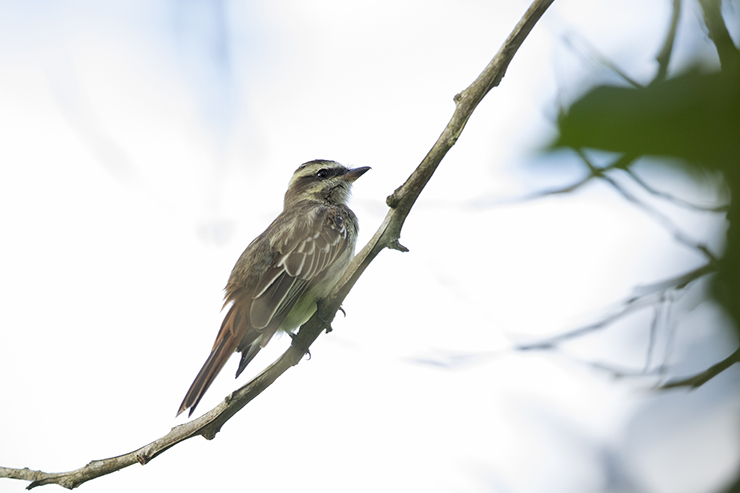
With my recent relocation to the central forests of Trinidad, I have been afforded the incredible opportunity of observing three oft-confused species in close proximity to one another. Frequently the field guide presents a curated selection of species on the same plate to illustrate key differences essential to nailing a positive identification. In reality these species are rarely in the same place at the same time, however!
On occasion the species in question may share habitat, thus it may be possible to perceive the size difference between Lesser Yellowlegs and Greater Yellowlegs, as opposed to relying on more subtle field characteristics such as the ratio of bill length to head length. The birds I’m referring to in this post are all flycatchers that occupy woody, forest habitat; but they are very infrequently in the same place at the same time. Some days ago I was guiding a couple here and we encountered all three, Streaked Flycatcher, Variegated Flycatcher, and Piratic Flycatcher – hence the motivation for this consideration.
The largest and bulkiest of the three is the more or less ever-present Streaked Flycatcher. With a powerful, hooked bill, it dismembers cicadas, beetles, and large grasshoppers with ease. Like many other flycatchers, it supplements its arthropod diet with fruits and berries from the forest. Of the three, the Streaked Flycatcher is easiest to discern, for it is often vocalising loudly throughout the day. Even if it is silent, its large size, thick, two-toned bill, and prevalence of rufous on its plumage are all distinctive field marks.

Streaked Flycatcher

Two Streaked Flycatchers posture to each other. Note the extensive rufous on the tail.
While the bird above recalls a Great Kiskadee in size and structure, both Variegated and Piratic Flycatchers are considerably smaller and slimmer. Variegated Flycatcher is the intermediate in terms of size and plumage – it maintains some rufous on its rump and tail and also has a two-toned (albeit much smaller) bill.

Variegated Flycatcher

Interestingly though, some Variegated Flycatchers have bills that are all dark!
The Piratic Flycatcher is the smallest of the three, and often the most vocal. Its strident call can be one of the more recognisable and far-reaching vocalisations within the soundscape of forests at most elevations on both Trinidad and Tobago. All three species mentioned in this article breed on these islands, but the Piratic Flycatcher employs a truly piratic strategy: the breeding pair targets a recently built woven nest, often by a Yellow Oriole or Yellow-rumped Cacique but they have also been recorded targeting the nests of other flycatchers. When I say they target the nest, what I really mean is that they target the present occupiers and rightful owners of the nest. By constant harassment, egg ejection, and in some cases hatchling removal, the original owners abandon ship and the Piratic Flycatchers move in. Sometimes they may redecorate a bit within the nest with dead leaves or other material. Unlike brood parasites, they raise their own young in their pirated nest.

Piratic Flycatchers have no significant rufous plumage, nor do they have any pink base to their tiny bill.
In separating Piratic Flycatcher from Variegated Flycatcher, I have found it most useful to inspect the facial pattern. The dark mask of the Piratic Flycatcher tends to widen significantly behind the eye, while the corresponding feature on the Variegated Flycatcher does not. Instead, the white cheekband on the latter species fattens beyond the eye.

The bird above seems to have a black mask that widens beyond the eye, but its two-toned bill says it is a Variegated Flycatcher. The bird pictured below seems to have rufous on its rump, but this is merely the well-documented rusty cinnamon or fulvous edging on the uppertail coverts of a Piratic Flycatcher.

While voice is a useful identifier, the Variegated Flycatcher is notoriously silent, even during breeding. Both it and the Piratic Flycatcher enjoy perching at height on bare branches and from a distance silent birds can pose a challenge to identify. With patience, however, once the bird embarks upon a sally to pursue a nearby insect the presence or absence of rufous can easily be discerned.

Variegated Flycatcher
Individualism is rife among birds the closer one inspects, and for these similar species oftentimes multiple boxes must be checked prior to making a confident ID call. All the more reason to keep birding!













Great write-up on these 3 cousins Faraaz.
Very educational as usual, thanks Faraaz